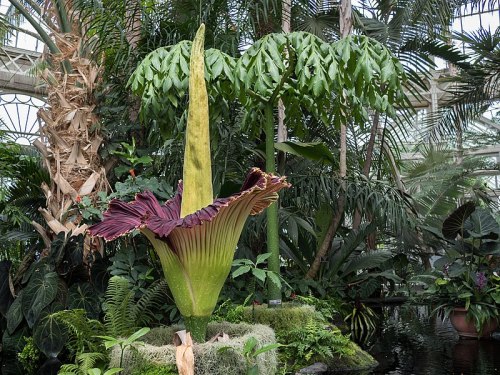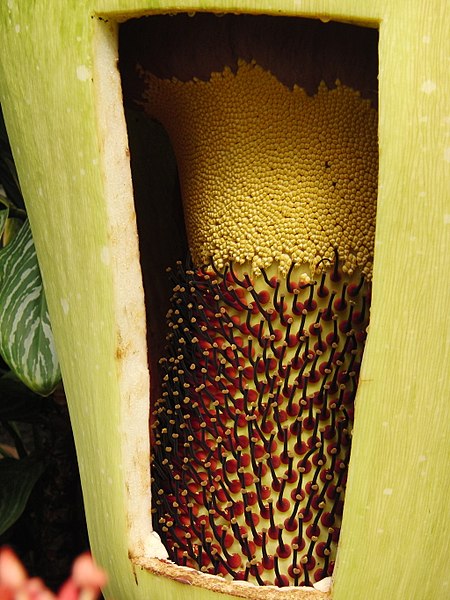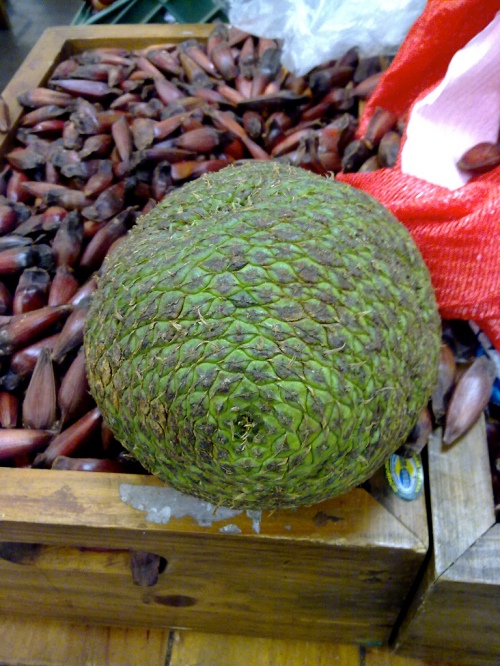by Piter Kehoma Boll
Today our fellow is another star of the plant kingdom and you probably heard of it before. Growing in the rainforests of Sumatra and Java, this species has a giant inflorescence and emits a smell of rotten meat, sometimes being called corpse flower, but do not mistake it for another rotten meat-smelling giant flower from the same place, the corpse flower Rafflesia arnoldi already presented here some years ago.

The giant inflorescence of the titan arum. Photo by Wikimedia user Rhododendrites.*
The name of today’s species if Amorphophallus titanum, which literally means something like “titan shapeless penis”. The name may not please many audiences, so the common name “titan arum” was coined by the British naturalist and broadcaster David Attenborough.
The titan arum belongs to the family Araceae, the same that includes some popular garden plants such as the anthurium. It is the flowering plant with the largest unbranched inflorescence in the world. The giant structure is not a single flower, but a giant inflorescence, called spadix, containing many small flowers and surrounded by a single petal-like leaf called spathe. In most species of Araceae the whole spadix contains flowers, but in the titan arum they are present only at two rings at the base, an upper ring of male flowers and a lower ling of female flowers. Most of the spadix is just a giant hollow appendix.

Male flowers (above) and female flowers (below) seen through a cut of the spathe. Photo by Wikimedia user Rosetta.**
The inflorescence of the titan arum can reach over 3 meters in height. It emits a fragrance that resembles that of rotting meat and attracts the pollinators, which are carrion-eating beetles and flesh flies. In fact, the odor changes during the opening and maturation of the inflorescence, but always resembles something decomposing. While the spathe is opening, the smell is more like that of rotten fruits, a few hours later it changes to a more rotten-egg smell and then to a real rotting-meat smell. During this last phase, the temperature of the inflorescence increases, reaching up to 36°C, about the temperature of a mammal, and this is considered as a probable additional feature to simulate the rotting meat appearance of the structure. Furthermore, the inner surface of the spathe has a deep-red to purple color that also resembles rotting meat.

The single giant leaf of the titan arum. Photo by Emőke Dénes.*
Like many giant-flowered or giant-inflorescenced species, the titan arum is not a very leafy species. While the inflorescence is growing and opening, the plants does not have any leaf. After the inflorescence dies and fruits are produced, a single giant leaf starts to grow from the plants subterranean corm (a stem working as a storage organ), reaching the size of a small tree. The corm, as everything in this species, is also giant, being the largest known corm in the world, usually reaching aroound 50 kg, but some specimens in botanical gardens going beyond 100 kg after some years.

The giant corm of the titan arum. Photo by Wikimedia user Georgialh.*
The titan arum is really one of the most remarkable species on our planet. Don’t you agree?
– – –
– – –
References:
Korotkova, N.; Barthlott, W. (2009) On the thermogenesis of the Titan arum (Amorphophallus titanum). Plant Signaling & Behavior, 4(11): 1096–1098.
Shirasu, M.; Fujioka, K.; Kakishima, S.; Nagai, S.; Tomizawa, Y.; Tsukaya, H.; Murata, J.; Manome, Y.; Touhara, K. (2010) Chemical identity of a rotting animal-like odor emitted from the inflorescence of the titan arum (Amorphophallus titanum). Bioscience, Biotechnology and Biochemistry 74(12): 2550–2554.
Wikipedia. Amorphophallus titanum. Available at < https://en.wikipedia.org/wiki/Amorphophallus_titanum >. Access on June 14, 2018.
– – –
*
This work is licensed under a Creative Commons Attribution-ShareAlike 4.0 International License.
**
This work is licensed under a Creative Commons Attribution-ShareAlike 3.0 Unported License.









